Woolworths: E-Business Solutions, Models, and Implementation Plan
VerifiedAdded on 2023/06/09
|11
|2284
|52
Report
AI Summary
This report examines e-business solutions for Woolworths, an Australian supermarket chain. It begins by analyzing Woolworths' business direction, competitive position, and market trends. The report then investigates e-business opportunities, evaluating various e-business models and proposing solutions, including e-commerce and e-marketing strategies. A key component is the application of value chain analysis to assess the potential of these solutions. The report also identifies relevant legislation, regulations, and standards affecting implementation, followed by a comparative analysis of different e-business models. Finally, the report outlines an implementation plan for the proposed e-business solutions, emphasizing the importance of customer relations, feedback mechanisms, and effective marketing strategies. The references section provides a comprehensive list of sources used in the analysis.

0 | a g eP
Paraphrase This Document
Need a fresh take? Get an instant paraphrase of this document with our AI Paraphraser
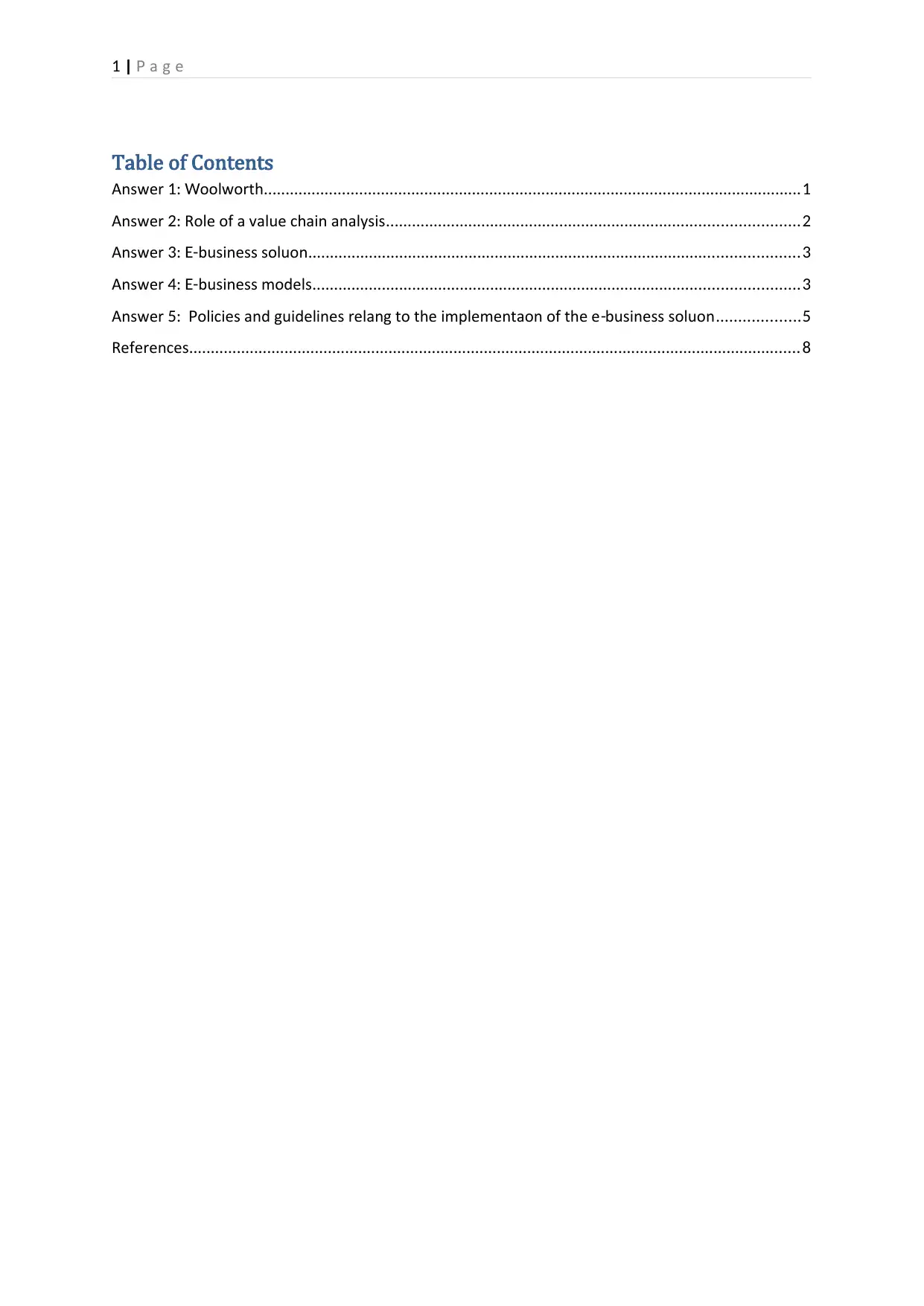
1 | a g eP
Table of Contents
Answer oolworth1: W ............................................................................................................................1
Answer Role of a value chain analysis2: ...............................................................................................2
Answer business solution3: E- .................................................................................................................3
Answer business models4: E- ................................................................................................................3
Answer olicies and guidelines relating to the implementation of the e business solution5: P - ...................5
References.............................................................................................................................................8
Table of Contents
Answer oolworth1: W ............................................................................................................................1
Answer Role of a value chain analysis2: ...............................................................................................2
Answer business solution3: E- .................................................................................................................3
Answer business models4: E- ................................................................................................................3
Answer olicies and guidelines relating to the implementation of the e business solution5: P - ...................5
References.............................................................................................................................................8
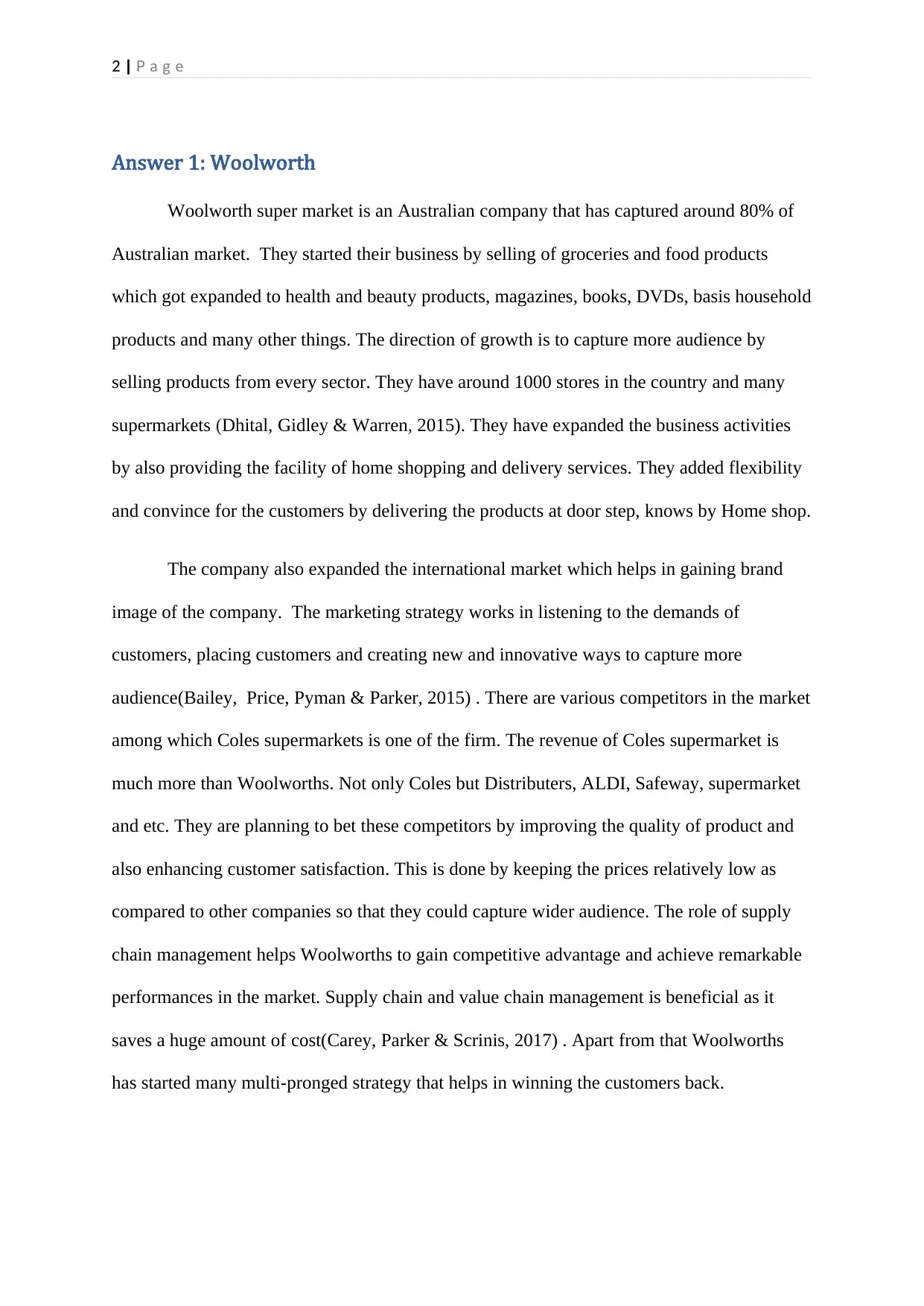
2 | a g eP
Answer 1: Woolworth
Woolworth super market is an Australian company that has captured around 80% of
Australian market. They started their business by selling of groceries and food products
which got expanded to health and beauty products, magazines, books, DVDs, basis household
products and many other things. The direction of growth is to capture more audience by
selling products from every sector. They have around 1000 stores in the country and many
supermarkets (Dhital, Gidley & Warren, 2015). They have expanded the business activities
by also providing the facility of home shopping and delivery services. They added flexibility
and convince for the customers by delivering the products at door step, knows by Home shop.
The company also expanded the international market which helps in gaining brand
image of the company. The marketing strategy works in listening to the demands of
customers, placing customers and creating new and innovative ways to capture more
audience(Bailey, Price, Pyman & Parker, 2015) . There are various competitors in the market
among which Coles supermarkets is one of the firm. The revenue of Coles supermarket is
much more than Woolworths. Not only Coles but Distributers, ALDI, Safeway, supermarket
and etc. They are planning to bet these competitors by improving the quality of product and
also enhancing customer satisfaction. This is done by keeping the prices relatively low as
compared to other companies so that they could capture wider audience. The role of supply
chain management helps Woolworths to gain competitive advantage and achieve remarkable
performances in the market. Supply chain and value chain management is beneficial as it
saves a huge amount of cost(Carey, Parker & Scrinis, 2017) . Apart from that Woolworths
has started many multi-pronged strategy that helps in winning the customers back.
Answer 1: Woolworth
Woolworth super market is an Australian company that has captured around 80% of
Australian market. They started their business by selling of groceries and food products
which got expanded to health and beauty products, magazines, books, DVDs, basis household
products and many other things. The direction of growth is to capture more audience by
selling products from every sector. They have around 1000 stores in the country and many
supermarkets (Dhital, Gidley & Warren, 2015). They have expanded the business activities
by also providing the facility of home shopping and delivery services. They added flexibility
and convince for the customers by delivering the products at door step, knows by Home shop.
The company also expanded the international market which helps in gaining brand
image of the company. The marketing strategy works in listening to the demands of
customers, placing customers and creating new and innovative ways to capture more
audience(Bailey, Price, Pyman & Parker, 2015) . There are various competitors in the market
among which Coles supermarkets is one of the firm. The revenue of Coles supermarket is
much more than Woolworths. Not only Coles but Distributers, ALDI, Safeway, supermarket
and etc. They are planning to bet these competitors by improving the quality of product and
also enhancing customer satisfaction. This is done by keeping the prices relatively low as
compared to other companies so that they could capture wider audience. The role of supply
chain management helps Woolworths to gain competitive advantage and achieve remarkable
performances in the market. Supply chain and value chain management is beneficial as it
saves a huge amount of cost(Carey, Parker & Scrinis, 2017) . Apart from that Woolworths
has started many multi-pronged strategy that helps in winning the customers back.
⊘ This is a preview!⊘
Do you want full access?
Subscribe today to unlock all pages.

Trusted by 1+ million students worldwide
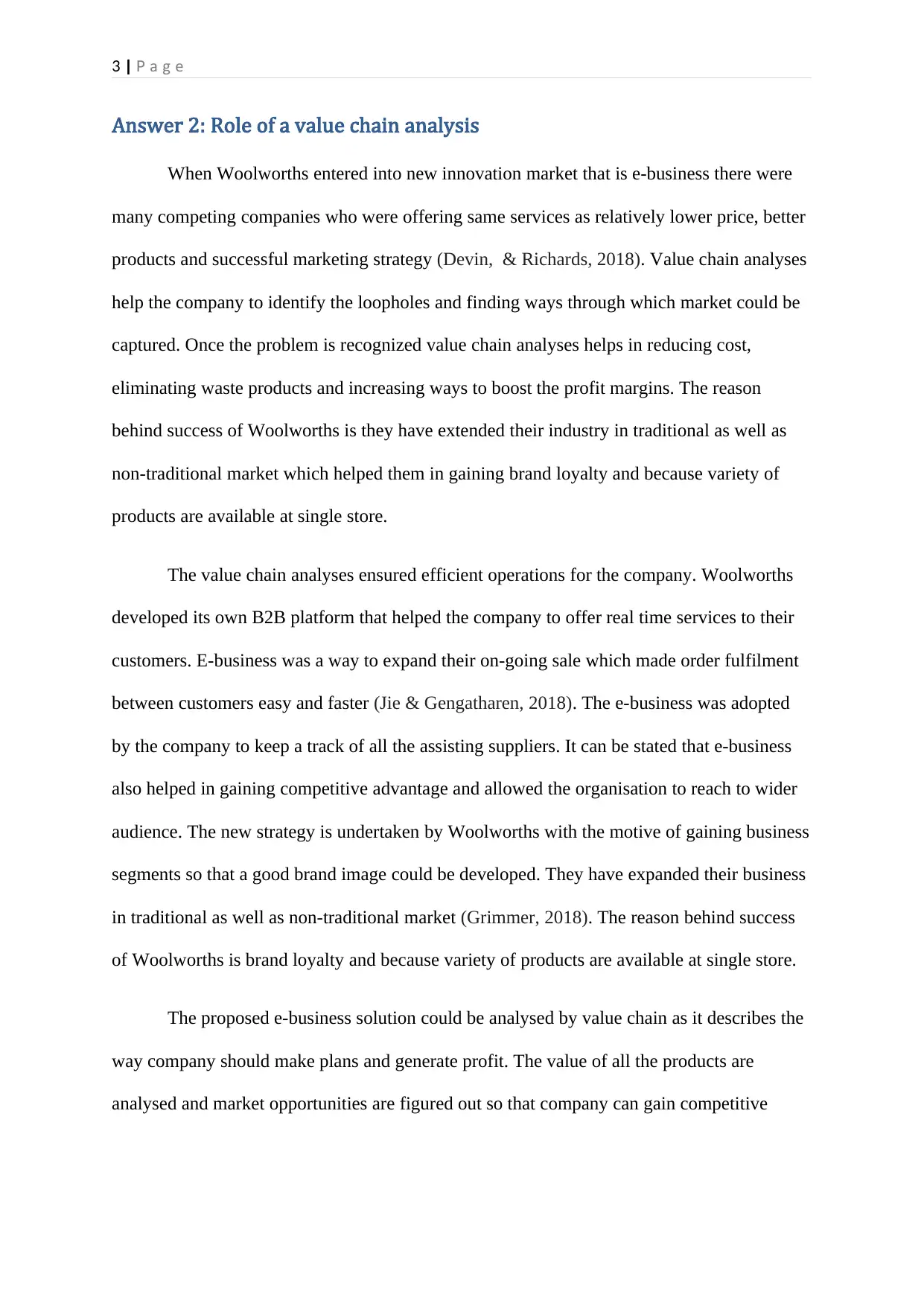
3 | a g eP
Answer 2: Role of a value chain analysis
When Woolworths entered into new innovation market that is e-business there were
many competing companies who were offering same services as relatively lower price, better
products and successful marketing strategy (Devin, & Richards, 2018). Value chain analyses
help the company to identify the loopholes and finding ways through which market could be
captured. Once the problem is recognized value chain analyses helps in reducing cost,
eliminating waste products and increasing ways to boost the profit margins. The reason
behind success of Woolworths is they have extended their industry in traditional as well as
non-traditional market which helped them in gaining brand loyalty and because variety of
products are available at single store.
The value chain analyses ensured efficient operations for the company. Woolworths
developed its own B2B platform that helped the company to offer real time services to their
customers. E-business was a way to expand their on-going sale which made order fulfilment
between customers easy and faster (Jie & Gengatharen, 2018). The e-business was adopted
by the company to keep a track of all the assisting suppliers. It can be stated that e-business
also helped in gaining competitive advantage and allowed the organisation to reach to wider
audience. The new strategy is undertaken by Woolworths with the motive of gaining business
segments so that a good brand image could be developed. They have expanded their business
in traditional as well as non-traditional market (Grimmer, 2018). The reason behind success
of Woolworths is brand loyalty and because variety of products are available at single store.
The proposed e-business solution could be analysed by value chain as it describes the
way company should make plans and generate profit. The value of all the products are
analysed and market opportunities are figured out so that company can gain competitive
Answer 2: Role of a value chain analysis
When Woolworths entered into new innovation market that is e-business there were
many competing companies who were offering same services as relatively lower price, better
products and successful marketing strategy (Devin, & Richards, 2018). Value chain analyses
help the company to identify the loopholes and finding ways through which market could be
captured. Once the problem is recognized value chain analyses helps in reducing cost,
eliminating waste products and increasing ways to boost the profit margins. The reason
behind success of Woolworths is they have extended their industry in traditional as well as
non-traditional market which helped them in gaining brand loyalty and because variety of
products are available at single store.
The value chain analyses ensured efficient operations for the company. Woolworths
developed its own B2B platform that helped the company to offer real time services to their
customers. E-business was a way to expand their on-going sale which made order fulfilment
between customers easy and faster (Jie & Gengatharen, 2018). The e-business was adopted
by the company to keep a track of all the assisting suppliers. It can be stated that e-business
also helped in gaining competitive advantage and allowed the organisation to reach to wider
audience. The new strategy is undertaken by Woolworths with the motive of gaining business
segments so that a good brand image could be developed. They have expanded their business
in traditional as well as non-traditional market (Grimmer, 2018). The reason behind success
of Woolworths is brand loyalty and because variety of products are available at single store.
The proposed e-business solution could be analysed by value chain as it describes the
way company should make plans and generate profit. The value of all the products are
analysed and market opportunities are figured out so that company can gain competitive
Paraphrase This Document
Need a fresh take? Get an instant paraphrase of this document with our AI Paraphraser
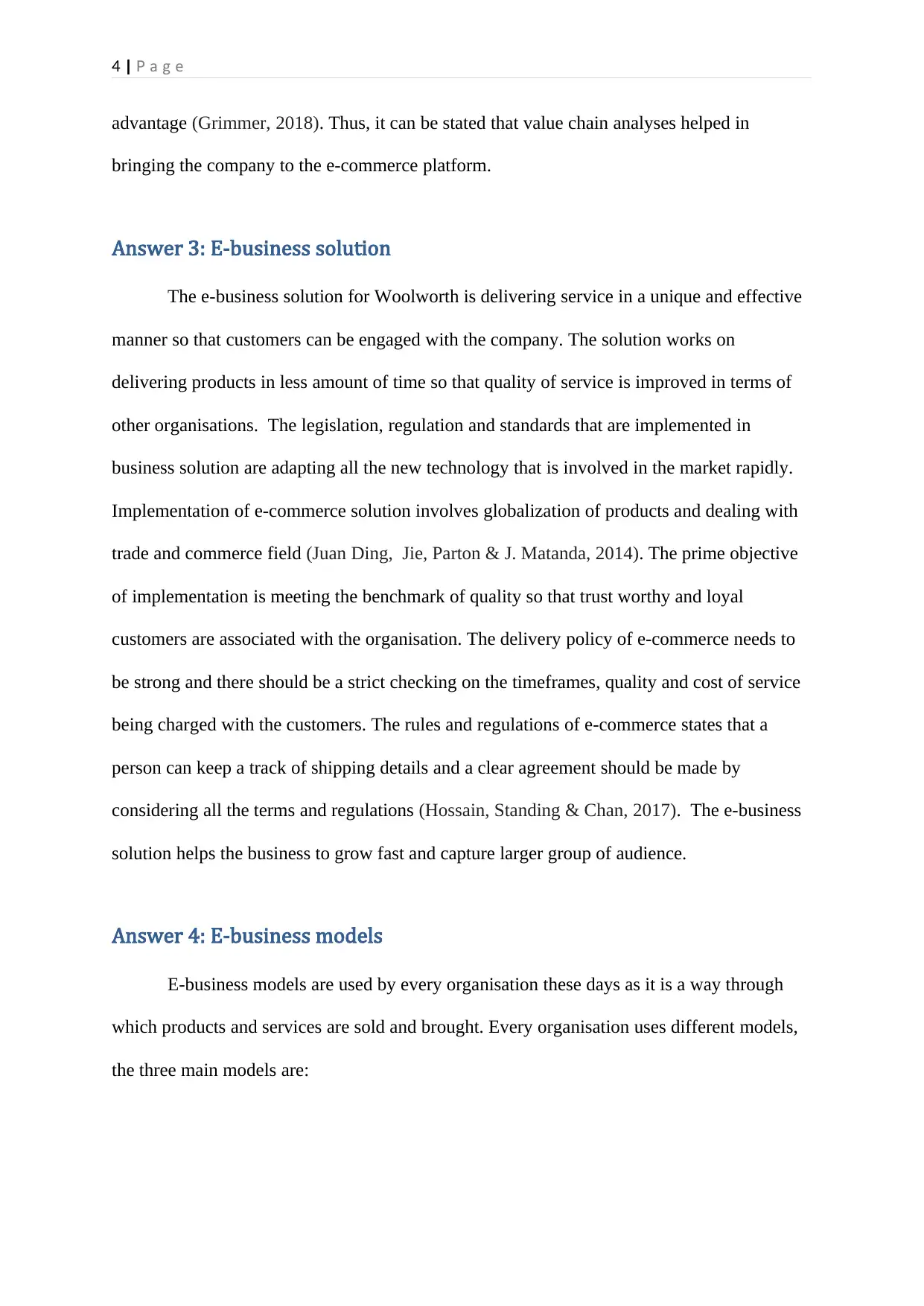
4 | a g eP
advantage (Grimmer, 2018). Thus, it can be stated that value chain analyses helped in
bringing the company to the e-commerce platform.
Answer 3: E-business solution
The e-business solution for Woolworth is delivering service in a unique and effective
manner so that customers can be engaged with the company. The solution works on
delivering products in less amount of time so that quality of service is improved in terms of
other organisations. The legislation, regulation and standards that are implemented in
business solution are adapting all the new technology that is involved in the market rapidly.
Implementation of e-commerce solution involves globalization of products and dealing with
trade and commerce field (Juan Ding, Jie, Parton & J. Matanda, 2014). The prime objective
of implementation is meeting the benchmark of quality so that trust worthy and loyal
customers are associated with the organisation. The delivery policy of e-commerce needs to
be strong and there should be a strict checking on the timeframes, quality and cost of service
being charged with the customers. The rules and regulations of e-commerce states that a
person can keep a track of shipping details and a clear agreement should be made by
considering all the terms and regulations (Hossain, Standing & Chan, 2017). The e-business
solution helps the business to grow fast and capture larger group of audience.
Answer 4: E-business models
E-business models are used by every organisation these days as it is a way through
which products and services are sold and brought. Every organisation uses different models,
the three main models are:
advantage (Grimmer, 2018). Thus, it can be stated that value chain analyses helped in
bringing the company to the e-commerce platform.
Answer 3: E-business solution
The e-business solution for Woolworth is delivering service in a unique and effective
manner so that customers can be engaged with the company. The solution works on
delivering products in less amount of time so that quality of service is improved in terms of
other organisations. The legislation, regulation and standards that are implemented in
business solution are adapting all the new technology that is involved in the market rapidly.
Implementation of e-commerce solution involves globalization of products and dealing with
trade and commerce field (Juan Ding, Jie, Parton & J. Matanda, 2014). The prime objective
of implementation is meeting the benchmark of quality so that trust worthy and loyal
customers are associated with the organisation. The delivery policy of e-commerce needs to
be strong and there should be a strict checking on the timeframes, quality and cost of service
being charged with the customers. The rules and regulations of e-commerce states that a
person can keep a track of shipping details and a clear agreement should be made by
considering all the terms and regulations (Hossain, Standing & Chan, 2017). The e-business
solution helps the business to grow fast and capture larger group of audience.
Answer 4: E-business models
E-business models are used by every organisation these days as it is a way through
which products and services are sold and brought. Every organisation uses different models,
the three main models are:
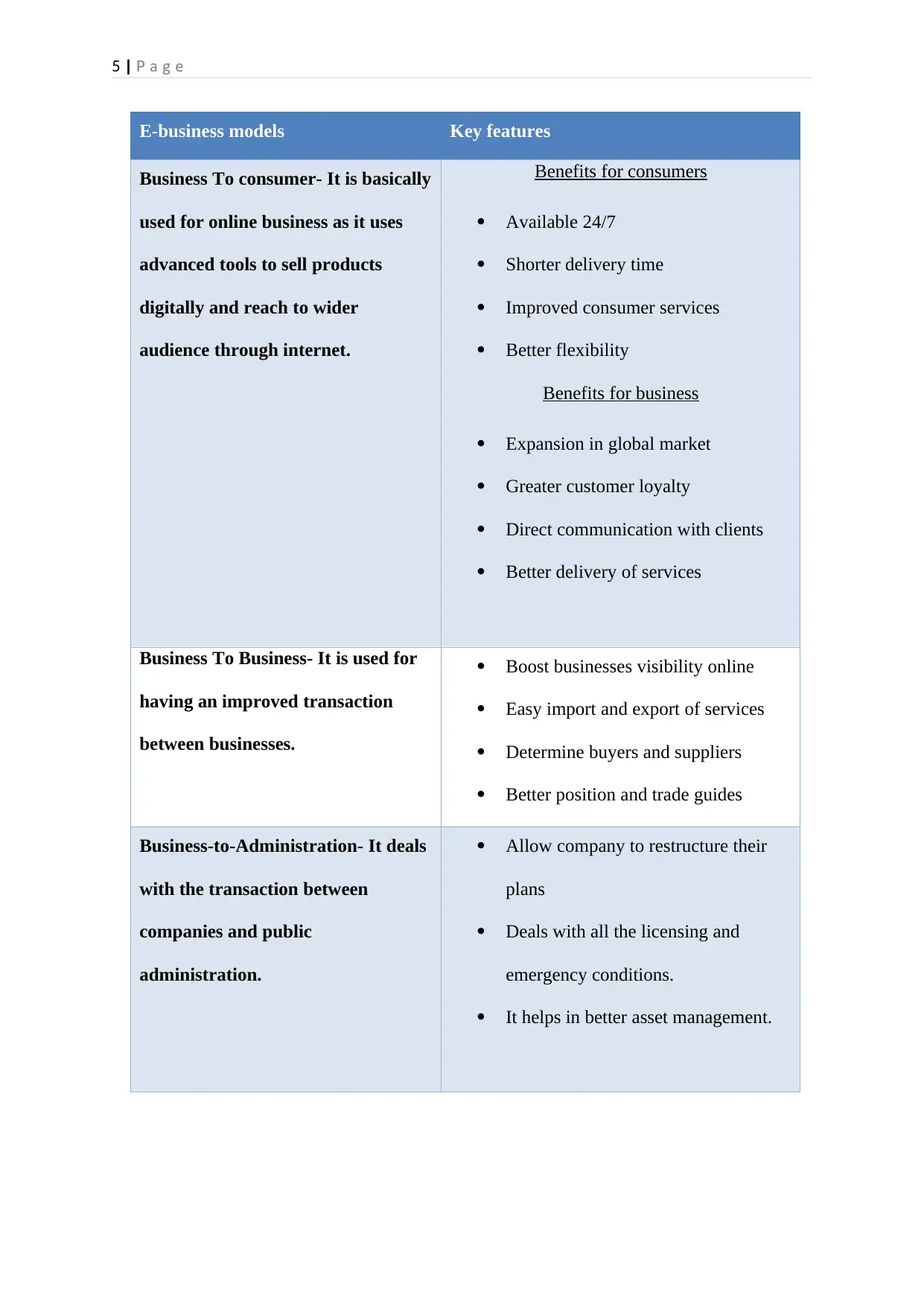
5 | a g eP
E-business models Key features
Business To consumer- It is basically
used for online business as it uses
advanced tools to sell products
digitally and reach to wider
audience through internet.
Benefits for consumers
Available 24/7
Shorter delivery time
Improved consumer services
Better flexibility
Benefits for business
Expansion in global market
Greater customer loyalty
Direct communication with clients
Better delivery of services
Business To Business- It is used for
having an improved transaction
between businesses.
Boost businesses visibility online
Easy import and export of services
Determine buyers and suppliers
Better position and trade guides
Business-to-Administration- It deals
with the transaction between
companies and public
administration.
Allow company to restructure their
plans
Deals with all the licensing and
emergency conditions.
It helps in better asset management.
E-business models Key features
Business To consumer- It is basically
used for online business as it uses
advanced tools to sell products
digitally and reach to wider
audience through internet.
Benefits for consumers
Available 24/7
Shorter delivery time
Improved consumer services
Better flexibility
Benefits for business
Expansion in global market
Greater customer loyalty
Direct communication with clients
Better delivery of services
Business To Business- It is used for
having an improved transaction
between businesses.
Boost businesses visibility online
Easy import and export of services
Determine buyers and suppliers
Better position and trade guides
Business-to-Administration- It deals
with the transaction between
companies and public
administration.
Allow company to restructure their
plans
Deals with all the licensing and
emergency conditions.
It helps in better asset management.
⊘ This is a preview!⊘
Do you want full access?
Subscribe today to unlock all pages.

Trusted by 1+ million students worldwide
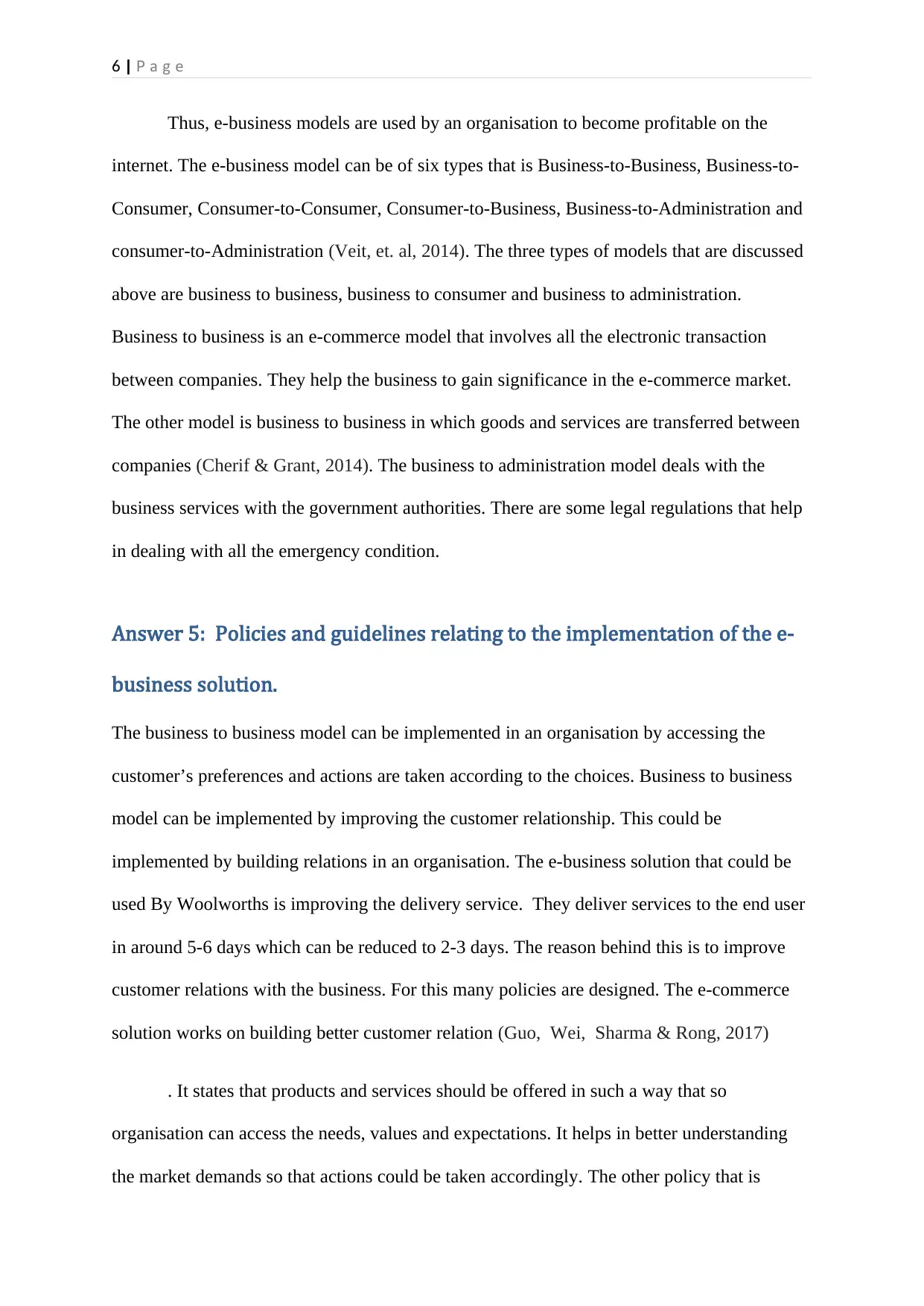
6 | a g eP
Thus, e-business models are used by an organisation to become profitable on the
internet. The e-business model can be of six types that is Business-to-Business, Business-to-
Consumer, Consumer-to-Consumer, Consumer-to-Business, Business-to-Administration and
consumer-to-Administration (Veit, et. al, 2014). The three types of models that are discussed
above are business to business, business to consumer and business to administration.
Business to business is an e-commerce model that involves all the electronic transaction
between companies. They help the business to gain significance in the e-commerce market.
The other model is business to business in which goods and services are transferred between
companies (Cherif & Grant, 2014). The business to administration model deals with the
business services with the government authorities. There are some legal regulations that help
in dealing with all the emergency condition.
Answer 5: Policies and guidelines relating to the implementation of the e-
business solution.
The business to business model can be implemented in an organisation by accessing the
customer’s preferences and actions are taken according to the choices. Business to business
model can be implemented by improving the customer relationship. This could be
implemented by building relations in an organisation. The e-business solution that could be
used By Woolworths is improving the delivery service. They deliver services to the end user
in around 5-6 days which can be reduced to 2-3 days. The reason behind this is to improve
customer relations with the business. For this many policies are designed. The e-commerce
solution works on building better customer relation (Guo, Wei, Sharma & Rong, 2017)
. It states that products and services should be offered in such a way that so
organisation can access the needs, values and expectations. It helps in better understanding
the market demands so that actions could be taken accordingly. The other policy that is
Thus, e-business models are used by an organisation to become profitable on the
internet. The e-business model can be of six types that is Business-to-Business, Business-to-
Consumer, Consumer-to-Consumer, Consumer-to-Business, Business-to-Administration and
consumer-to-Administration (Veit, et. al, 2014). The three types of models that are discussed
above are business to business, business to consumer and business to administration.
Business to business is an e-commerce model that involves all the electronic transaction
between companies. They help the business to gain significance in the e-commerce market.
The other model is business to business in which goods and services are transferred between
companies (Cherif & Grant, 2014). The business to administration model deals with the
business services with the government authorities. There are some legal regulations that help
in dealing with all the emergency condition.
Answer 5: Policies and guidelines relating to the implementation of the e-
business solution.
The business to business model can be implemented in an organisation by accessing the
customer’s preferences and actions are taken according to the choices. Business to business
model can be implemented by improving the customer relationship. This could be
implemented by building relations in an organisation. The e-business solution that could be
used By Woolworths is improving the delivery service. They deliver services to the end user
in around 5-6 days which can be reduced to 2-3 days. The reason behind this is to improve
customer relations with the business. For this many policies are designed. The e-commerce
solution works on building better customer relation (Guo, Wei, Sharma & Rong, 2017)
. It states that products and services should be offered in such a way that so
organisation can access the needs, values and expectations. It helps in better understanding
the market demands so that actions could be taken accordingly. The other policy that is
Paraphrase This Document
Need a fresh take? Get an instant paraphrase of this document with our AI Paraphraser
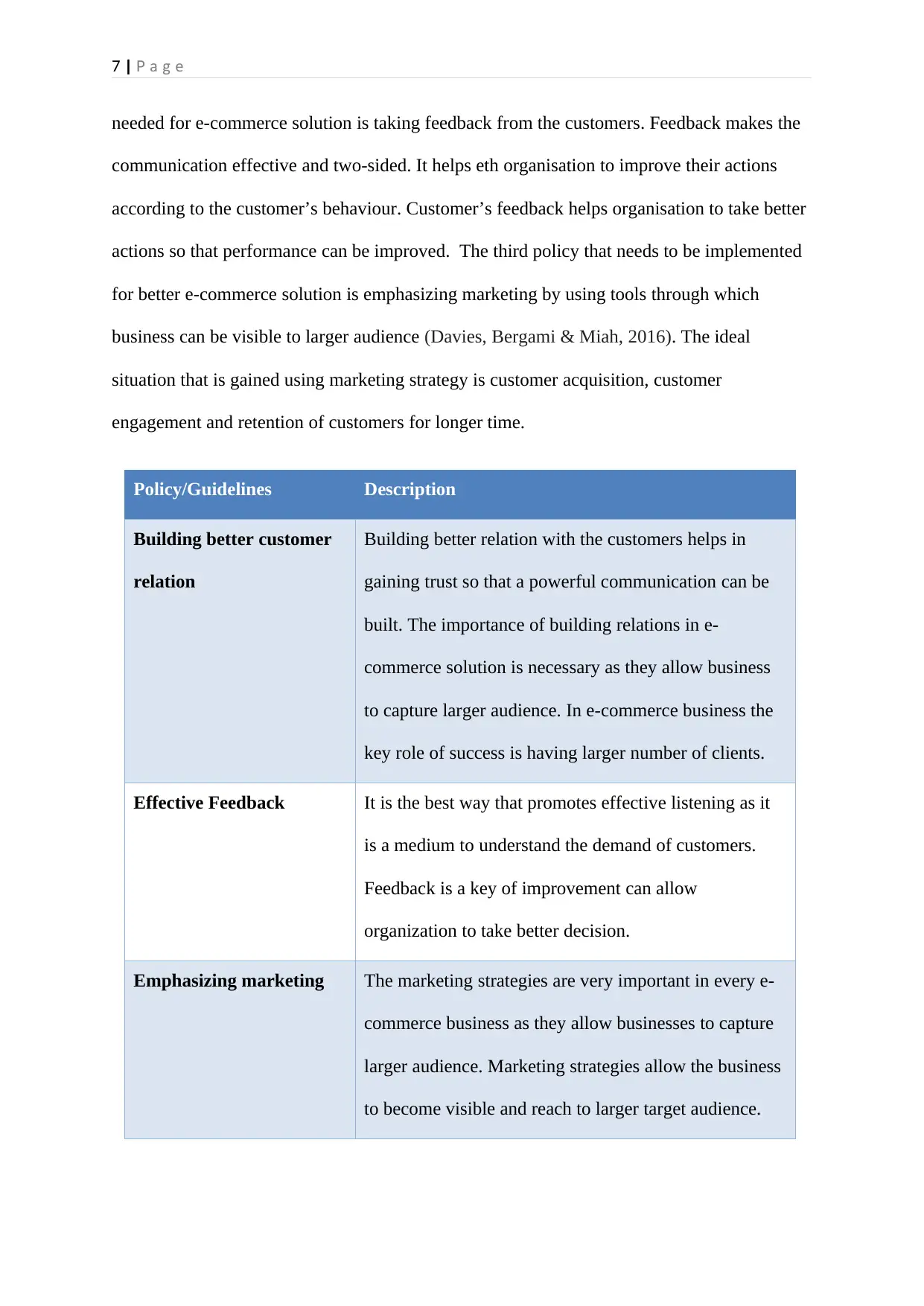
7 | a g eP
needed for e-commerce solution is taking feedback from the customers. Feedback makes the
communication effective and two-sided. It helps eth organisation to improve their actions
according to the customer’s behaviour. Customer’s feedback helps organisation to take better
actions so that performance can be improved. The third policy that needs to be implemented
for better e-commerce solution is emphasizing marketing by using tools through which
business can be visible to larger audience (Davies, Bergami & Miah, 2016). The ideal
situation that is gained using marketing strategy is customer acquisition, customer
engagement and retention of customers for longer time.
Policy/Guidelines Description
Building better customer
relation
Building better relation with the customers helps in
gaining trust so that a powerful communication can be
built. The importance of building relations in e-
commerce solution is necessary as they allow business
to capture larger audience. In e-commerce business the
key role of success is having larger number of clients.
Effective Feedback It is the best way that promotes effective listening as it
is a medium to understand the demand of customers.
Feedback is a key of improvement can allow
organization to take better decision.
Emphasizing marketing The marketing strategies are very important in every e-
commerce business as they allow businesses to capture
larger audience. Marketing strategies allow the business
to become visible and reach to larger target audience.
needed for e-commerce solution is taking feedback from the customers. Feedback makes the
communication effective and two-sided. It helps eth organisation to improve their actions
according to the customer’s behaviour. Customer’s feedback helps organisation to take better
actions so that performance can be improved. The third policy that needs to be implemented
for better e-commerce solution is emphasizing marketing by using tools through which
business can be visible to larger audience (Davies, Bergami & Miah, 2016). The ideal
situation that is gained using marketing strategy is customer acquisition, customer
engagement and retention of customers for longer time.
Policy/Guidelines Description
Building better customer
relation
Building better relation with the customers helps in
gaining trust so that a powerful communication can be
built. The importance of building relations in e-
commerce solution is necessary as they allow business
to capture larger audience. In e-commerce business the
key role of success is having larger number of clients.
Effective Feedback It is the best way that promotes effective listening as it
is a medium to understand the demand of customers.
Feedback is a key of improvement can allow
organization to take better decision.
Emphasizing marketing The marketing strategies are very important in every e-
commerce business as they allow businesses to capture
larger audience. Marketing strategies allow the business
to become visible and reach to larger target audience.

8 | a g eP
⊘ This is a preview!⊘
Do you want full access?
Subscribe today to unlock all pages.

Trusted by 1+ million students worldwide
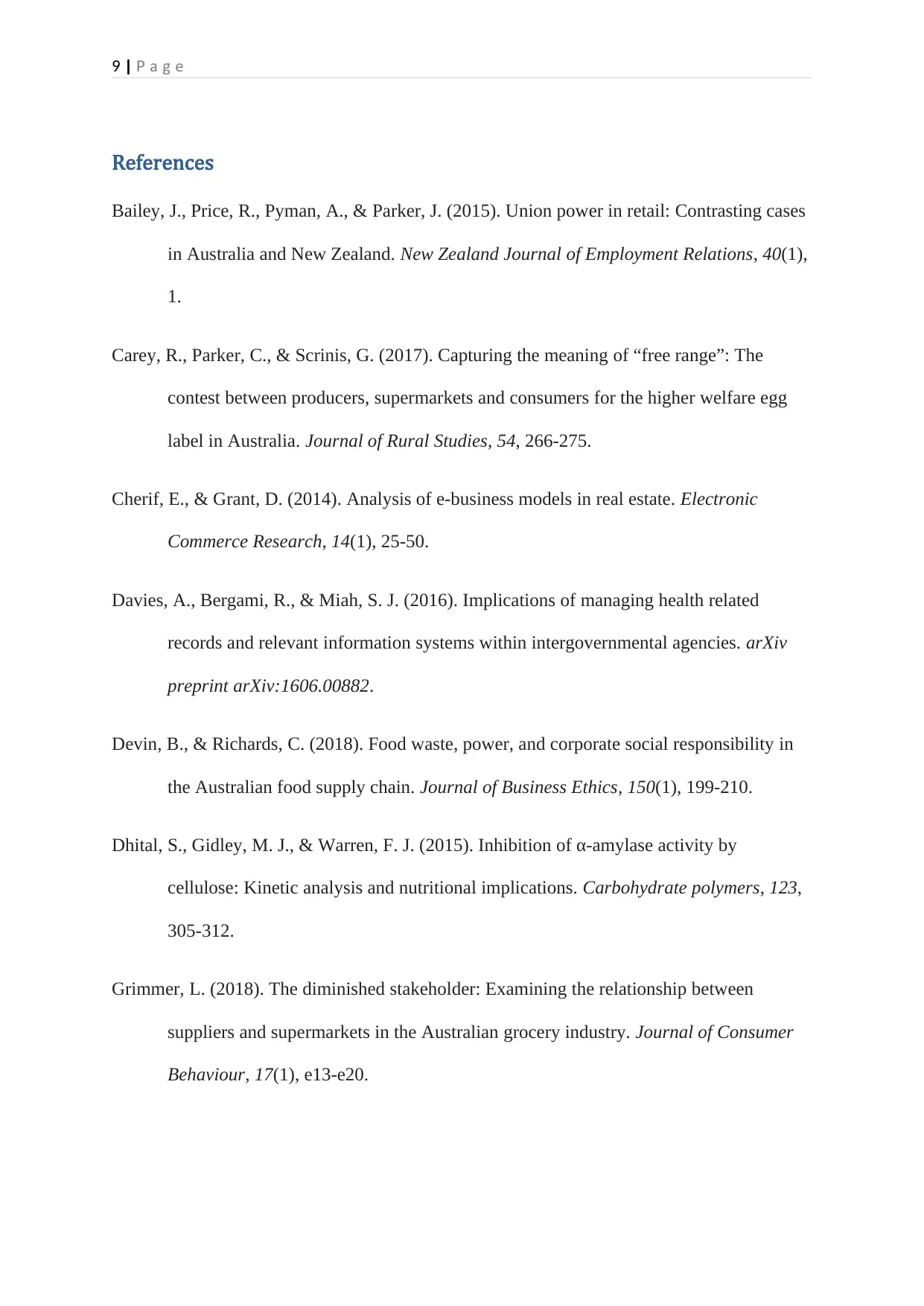
9 | a g eP
References
Bailey, J., Price, R., Pyman, A., & Parker, J. (2015). Union power in retail: Contrasting cases
in Australia and New Zealand. New Zealand Journal of Employment Relations, 40(1),
1.
Carey, R., Parker, C., & Scrinis, G. (2017). Capturing the meaning of “free range”: The
contest between producers, supermarkets and consumers for the higher welfare egg
label in Australia. Journal of Rural Studies, 54, 266-275.
Cherif, E., & Grant, D. (2014). Analysis of e-business models in real estate. Electronic
Commerce Research, 14(1), 25-50.
Davies, A., Bergami, R., & Miah, S. J. (2016). Implications of managing health related
records and relevant information systems within intergovernmental agencies. arXiv
preprint arXiv:1606.00882.
Devin, B., & Richards, C. (2018). Food waste, power, and corporate social responsibility in
the Australian food supply chain. Journal of Business Ethics, 150(1), 199-210.
Dhital, S., Gidley, M. J., & Warren, F. J. (2015). Inhibition of α-amylase activity by
cellulose: Kinetic analysis and nutritional implications. Carbohydrate polymers, 123,
305-312.
Grimmer, L. (2018). The diminished stakeholder: Examining the relationship between
suppliers and supermarkets in the Australian grocery industry. Journal of Consumer
Behaviour, 17(1), e13-e20.
References
Bailey, J., Price, R., Pyman, A., & Parker, J. (2015). Union power in retail: Contrasting cases
in Australia and New Zealand. New Zealand Journal of Employment Relations, 40(1),
1.
Carey, R., Parker, C., & Scrinis, G. (2017). Capturing the meaning of “free range”: The
contest between producers, supermarkets and consumers for the higher welfare egg
label in Australia. Journal of Rural Studies, 54, 266-275.
Cherif, E., & Grant, D. (2014). Analysis of e-business models in real estate. Electronic
Commerce Research, 14(1), 25-50.
Davies, A., Bergami, R., & Miah, S. J. (2016). Implications of managing health related
records and relevant information systems within intergovernmental agencies. arXiv
preprint arXiv:1606.00882.
Devin, B., & Richards, C. (2018). Food waste, power, and corporate social responsibility in
the Australian food supply chain. Journal of Business Ethics, 150(1), 199-210.
Dhital, S., Gidley, M. J., & Warren, F. J. (2015). Inhibition of α-amylase activity by
cellulose: Kinetic analysis and nutritional implications. Carbohydrate polymers, 123,
305-312.
Grimmer, L. (2018). The diminished stakeholder: Examining the relationship between
suppliers and supermarkets in the Australian grocery industry. Journal of Consumer
Behaviour, 17(1), e13-e20.
Paraphrase This Document
Need a fresh take? Get an instant paraphrase of this document with our AI Paraphraser
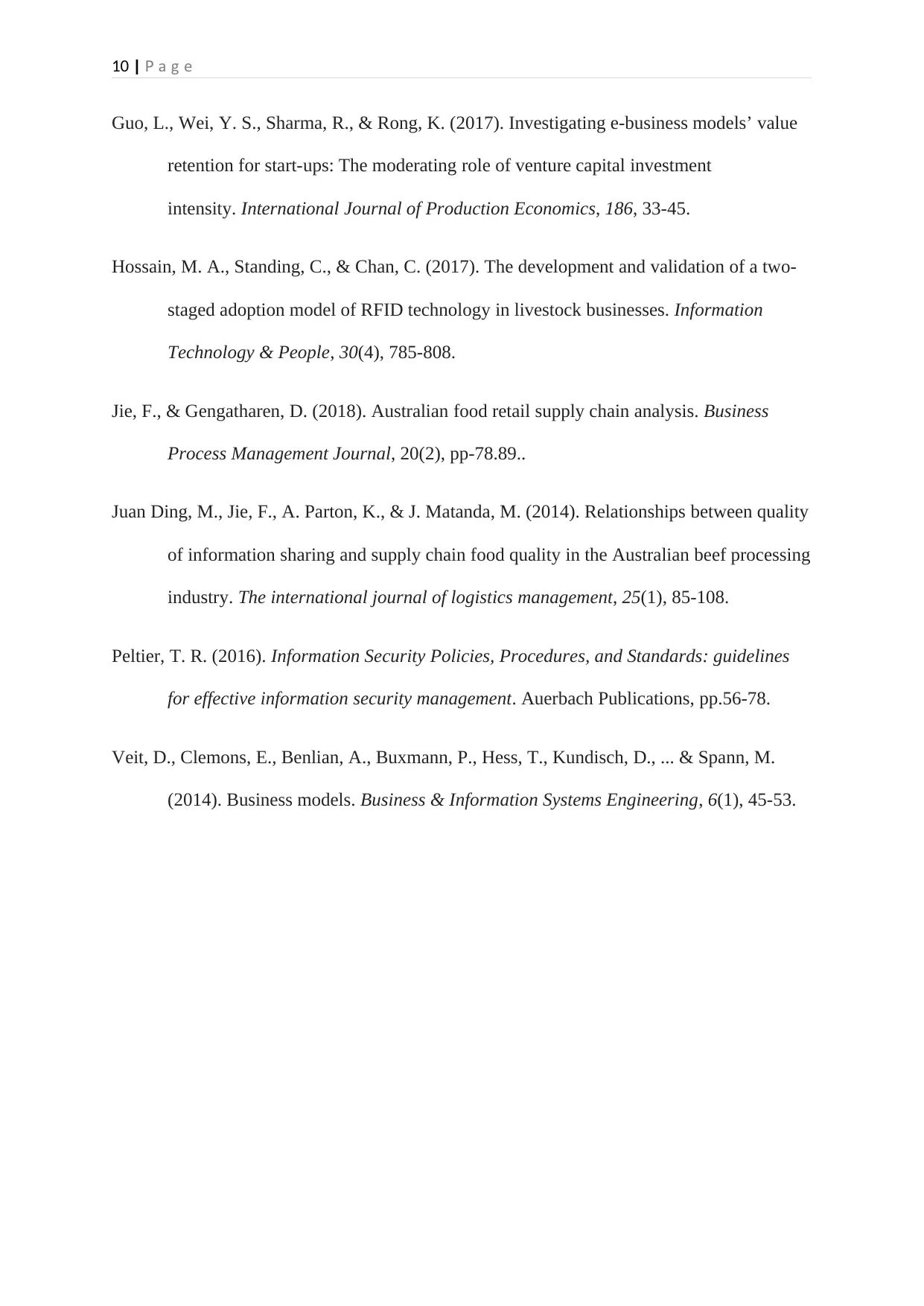
10 | a g eP
Guo, L., Wei, Y. S., Sharma, R., & Rong, K. (2017). Investigating e-business models’ value
retention for start-ups: The moderating role of venture capital investment
intensity. International Journal of Production Economics, 186, 33-45.
Hossain, M. A., Standing, C., & Chan, C. (2017). The development and validation of a two-
staged adoption model of RFID technology in livestock businesses. Information
Technology & People, 30(4), 785-808.
Jie, F., & Gengatharen, D. (2018). Australian food retail supply chain analysis. Business
Process Management Journal, 20(2), pp-78.89..
Juan Ding, M., Jie, F., A. Parton, K., & J. Matanda, M. (2014). Relationships between quality
of information sharing and supply chain food quality in the Australian beef processing
industry. The international journal of logistics management, 25(1), 85-108.
Peltier, T. R. (2016). Information Security Policies, Procedures, and Standards: guidelines
for effective information security management. Auerbach Publications, pp.56-78.
Veit, D., Clemons, E., Benlian, A., Buxmann, P., Hess, T., Kundisch, D., ... & Spann, M.
(2014). Business models. Business & Information Systems Engineering, 6(1), 45-53.
Guo, L., Wei, Y. S., Sharma, R., & Rong, K. (2017). Investigating e-business models’ value
retention for start-ups: The moderating role of venture capital investment
intensity. International Journal of Production Economics, 186, 33-45.
Hossain, M. A., Standing, C., & Chan, C. (2017). The development and validation of a two-
staged adoption model of RFID technology in livestock businesses. Information
Technology & People, 30(4), 785-808.
Jie, F., & Gengatharen, D. (2018). Australian food retail supply chain analysis. Business
Process Management Journal, 20(2), pp-78.89..
Juan Ding, M., Jie, F., A. Parton, K., & J. Matanda, M. (2014). Relationships between quality
of information sharing and supply chain food quality in the Australian beef processing
industry. The international journal of logistics management, 25(1), 85-108.
Peltier, T. R. (2016). Information Security Policies, Procedures, and Standards: guidelines
for effective information security management. Auerbach Publications, pp.56-78.
Veit, D., Clemons, E., Benlian, A., Buxmann, P., Hess, T., Kundisch, D., ... & Spann, M.
(2014). Business models. Business & Information Systems Engineering, 6(1), 45-53.
1 out of 11
Related Documents
Your All-in-One AI-Powered Toolkit for Academic Success.
+13062052269
info@desklib.com
Available 24*7 on WhatsApp / Email
![[object Object]](/_next/static/media/star-bottom.7253800d.svg)
Unlock your academic potential
Copyright © 2020–2025 A2Z Services. All Rights Reserved. Developed and managed by ZUCOL.





